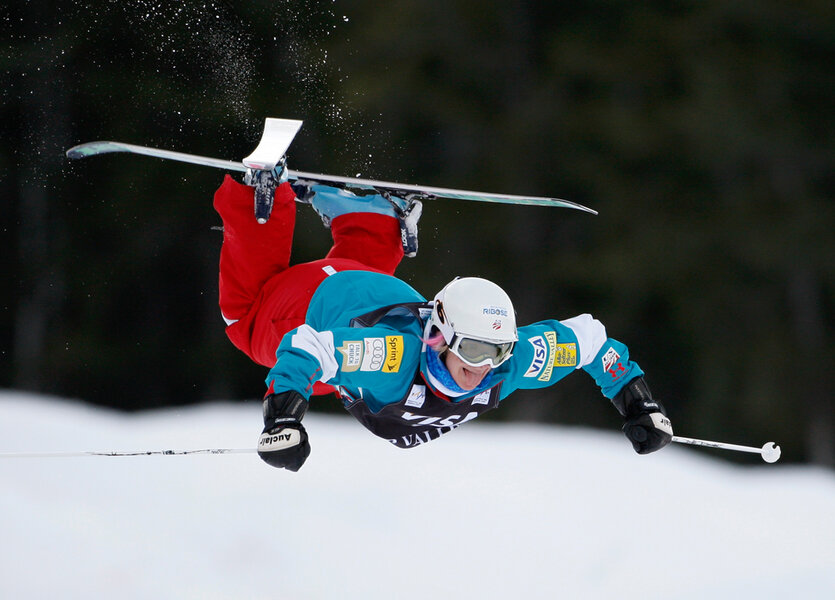Vancouver 2010 Olympic Games: Freestyle skiing
Loading...
Freestyle skiing will get a fresh jolt of adrenaline this year with the addition of the newest Olympic event: ski cross. An X-Games sport, it is similar to snowboard cross, which proved wildly popular at the 2006 Torino Olympics.
Both are part of an effort by the Olympic movement to broaden the appeal of the Games – long a bastion of highly specialized European sports, in other countries – including America, where a generation of teens raised on skateboards and video games feel little connection with sports such as luge and bobsledding.
Who to watch
Ryan St. Onge, USA (aerials) (see video)
With his win at the 2009 World Championships, St. Onge became the first American aerialist in a decade to earn the title. You wouldn’t guess it from his quiet demeanor though – or his diet. A favorite activity at his training base of Lake Placid, N.Y., is to head down to the local Ben & Jerry’s shop every month or so to tackle a Vermonster – 20 scoops of ice cream with hot fudge, cookies, brownies, and a slew of toppings – in a friendly eating competition with other local athletes.
But it’s not just flavors he likes to mix together; he’s working on a quintuple-twisting triple back somersault (three flips with five twists) to unveil in Vancouver, according to his website.
Ophélie David, France (ski cross) (see video)
A former Olympic Alpine skier, David has been No. 1 in the World Cup Ski Cross rankings since 2004. She brought home the bronze at 2005 Worlds, followed by gold in 2007. During the off-season, she cross-trains as a competitive mountain biker, winning, among other races, the Megavalanche, one of the world’s most prestigious downhill mountain biking races. She is no stranger to the Olympics; she competed in the slalom and combined events at the 1994 Lillehammer Games.
Watch David win the 2007 World Championships to get a flavor of her style.
Hannah Kearney, USA
Keep your eye on Kearney, last year’s overall World Cup winner in moguls who is currently ranked third in the world. A down-to-earth Vermonter, Kearney burst onto the international scene as a teenager, winning her first World Cup at age 17 in 2003. But unlike many in New England, she eschewed the ski academy track to finish public school – where she was a straight-A student – and trained with the Black and Blue Trail Smashers (BBTS) club in Waterville Valley, N.H.
Event Details
Click here for schedule and results.
Freestyle skiing breaks down into three different events: aerials, moguls, and ski cross.
-
Aerials: Athletes are given two opportunities to perform a series of flips, twists, and tucks off snow-covered jumps. Depending on the trick performed, aerialists choose from three ramp sizes, the largest being 8 meters (26 feet) above the landing zone. Scores are determined by the quality of the aerialists' take offs, height gained, form and body positions, and the quality of their landings.
After the initial qualifying round, the top 16 aerialist advance to compete in the finals. During this final round, athletes will jump twice more. The athlete with the highest combined final-round score wins.
-
Moguls: Racers ski one at a time down a slope covered with large mounds known as “moguls”. Skiers aim to maneuver around the moguls with high-quality, aggressive turns while sticking as close as possible to a direct path to the bottom of the slope. Each run is timed and compared to a pace-time set for the course, with the fast skiers receiving more points.
The slopes feature two “air bumps,” or jumps, over which skiers perform aerobatic tricks of their choosing. As in the aerial event, competitors are judged on the height of their jump, the difficulty and technique of the move, and their landings.
The two earned point values – for time and aerobatics – are combined and the skier with the highest score in the final round wins.
- Ski Cross: Four riders race head-to-head down a course composed of turns, jumps, straightaways, banks corners, and ridges. The top two skiers in each round advance. Ultimately, the top four skiers will have competed in four heats. To get a sense of it, watch this video.
History
Developed in America in the 1960s by skiers frustrated with the strict rules and conservative nature of alpine skiing, freestyle skiing is the flower child (and an aggressive one at that) of the Olympic skiing disciplines. Originally a mix of alpine skiing and acrobatics, the first freestyle skiing competition was held in Attitash, N.H., in 1966 and was recognized as a sport by the International Ski Federation in 1979.
Originally, freestyle was considered a messy sport, rife with injuries and lacking in rules and regulation. As its disciplines and techniques became more clearly defined and its popularity increased, freestyle moguls were made an Olympic discipline in 1992. The aerials event was first included in the 1994 Lillehammer Games. Vancouver will be the first city to host ski cross as an official Olympic sport.
Sources: nbcolympics.com, vancouver2010.com, olympic.ca, Oxford Encyclopedia of World Sports






